November 2019
1. First of all, tell me—what is a Forest Bather?
“The person leading the walk is the guide. The forest is the therapist.”
—Jeanne Christie
By Laurie Gallardo
 As a young sports reporter working for The Ellsworth American in the late 1970s, Jeanne Christie never imagined she’d get lost in the forest—and love it.
As a young sports reporter working for The Ellsworth American in the late 1970s, Jeanne Christie never imagined she’d get lost in the forest—and love it.
“I moved to Maine during my second year at Indiana University Bloomington,” she says. “I came back to spend the summer with my grandmother. I’d planned to return to school in the fall, but she was diagnosed with terminal cancer.”
“When I got the job with The Ellsworth American, I had to cover the Ellsworth High School boys basketball, which was the premier event of the winter season,” she says. “I didn’t know anything about sports when I took it.” In time, she became the weekly sports editor and chief photographer.
Fast forward nearly 40 years. Christie has become an award-winning wetland preservationist—and certified forest therapy guide—with assignments from the United States Environmental Protection Agency to the U.S. Department of Agriculture to the Association of State Wetland Managers, where she worked as executive director for nearly two decades.
How do you switch from sports to sensitively covering nature? “I asked my editor what I should focus on. He said environmental journalism.” So she transferred to the University of Maine at Presque Isle and graduated with a degree in environmental science and political science.
Christie landed a job in 1985 as a program and planning analyst at the Wisconsin Department of Natural Resources. After three years, she got married, moved to Washington D.C., and began working for the EPA. The laws granting wetlands protection were minimal, but soon enough, things began to evolve. Christie was at the forefront.
“The whole national arena changed. Suddenly, there were all kinds of new regulations that were embedded in the law to protect wetlands.” Her career kicked off.
Christie became a driving force in the development of state and national strategies for wetland protection, conservation, and restoration, including state and federal implementation of the Clean Water Act, particularly Section 404, which deals with dredge and fill permits. “Our success was possible only because of the contributions of many individuals, agencies, and organizations working together,” she says. “Changing environmental programs and policies is a big lift and always a group effort. That’s what makes natural resources so fascinating—you can never rest on your laurels.”
Though Christie continues to work as a consultant at Christie Consulting Services, just over a year ago she started Connect to Wilderness, where she takes individuals on nature walks as a certified forest therapy guide.
“We have a relationship with nature that goes back millennia, but there’s been a separation,” Christie says. “A couple of years ago, during my daily run in the woods with my dog, I stopped and heard what sounded like a shout—with no sound—making me pause and look at the forest around me. All of a sudden, I was just heavily falling into the natural world surrounding me. I couldn’t figure out the context. Then I saw a newspaper article on guided forest therapy training.”
As a guide, Christie does just that—leads those who are searching for oneness with nature.
“The guide is not a teacher or a leader, and I certainly don’t know how to be a therapist,” she says. “The person leading the walk is the guide, and the forest is the therapist. It’s between you and the natural world. It’s not my job to deliver the experience—I just provide the invitation.”





0 Comments